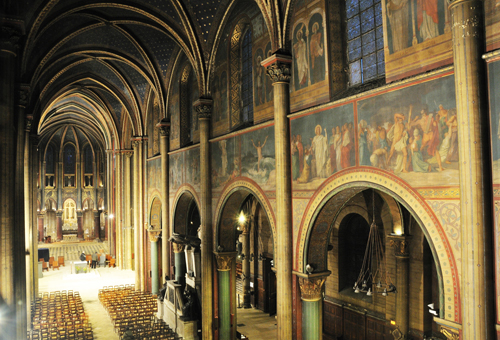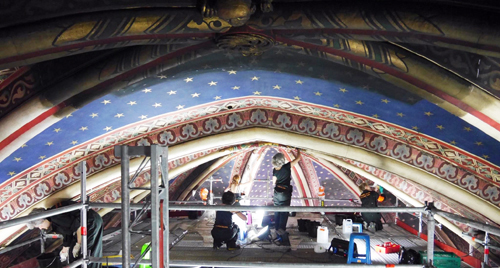Speak Out: The Logistics of Preserving a Cultural Icon
By David Sheppe
arttimesjournal February 10, 2018
Historical preservation of art and architecture is doubtlessly one of the most meaningful ways that we, as a modern people, can stay attuned to where we’ve come from and how we came to be where we are as a species. By preserving these tangible pieces of the past, we not only learn about the people of that day and time, but we are given a depth of opportunity for self-reflection, as well. After all, we only exist because they existed.
When it comes to preserving works that have reached iconic status within our modern culture, however, there are some unique concerns and considerations that must come into play. And those are on top of the existing necessities involved in preservation of such artifacts. One prime case in point is the magnificent Saint Germain des Prés, the oldest church in Paris.
Sociocultural Considerations
 The Church of Saint Germain des Prés |
Named for one of the original bishops of Paris in 543, Saint Germain des Prés has seen the city through from the Middle Ages to the modern day. When Paris was first established, it existed only on the two natural islands in the middle of the Seine River. The church was just outside the city at that time, but as the city built up and out over the centuries, it did so all around the steadfast “église de Saint Germain des Prés.” The church became a central element of the community and indeed gave its name to the surrounding neighborhood, now known simply as Saint Germain des Prés. As far as we know, this is the only neighborhood in Paris to have taken its name from the local church rather than vice-versa.
Anyone who has lived in or visited the city can attest to the fact that the Saint Germain des Prés neighborhood — in the very heart of the Latin Quarter — is quintessentially Paris. Its cafés are the stuff of any Paris movie scene, and the church is the central figure around which the neighborhood has wrapped itself. More than just a cultural relic, the church still holds regular weekly services for parishioners and welcomes those of any beliefs throughout the week to enjoy its contemplative and peaceful space. With its significance to the local community and the 700,000 tourists who visit St. Germain each year, allowing the church to fall prey to the ravages of time would be devastating — both to the residents of the Latin Quarter and those who visit it looking for a taste of the essence of Parisian life. Even with this consideration alone, the church would be worth restoring. When we then add in the cultural significance of 15 centuries of history and the potential loss due to benign neglect resulting from lack of funding, the necessity of restoration reaches a crucial tipping point.
The Church of Saint Germain des Prés — the building and its artwork — reflects many eras of French history, art and culture. As the oldest church in Paris, it has influenced and shaped people, places and ideas throughout history, including the famous philosopher Descartes, the novelist Victor Hugo and generations of Sorbonne students and teachers. Its architecture is a fascinating compilation of styles, from Romanesque arches and capitals to Gothic elements in the nave and choir.
Walking through this house of worship is like taking a journey to the past. Visitors bear witness to centuries-old art depicting historical and religious figures, intricately decorated capitals portraying aspects of the Old and New Testaments, plants and animals, and even monastic life. Most notable are the vast mural works painted by Hippolyte Flandrin in the 19th century.
Every aspect of the church itself is a testament to French culture and history. Unfortunately, the overall condition of the church has deteriorated steadily throughout the centuries. Determined to halt this deterioration, the American Friends for the Preservation of Saint Germain des Prés are working with the City of Paris (which owns the building), the Regional Directorate for Cultural Affairs and the Endowment Fund for the Protection of Saint Germain des Prés to generate funds to restore and preserve this unique historical monument.
Practical Considerations
The meaning and cultural significance of the restoration of Saint Germain des Prés aside — though one can never truly sidestep this — there are a number of practical factors that come into play to allow restoration work to move forward successfully. Firstly, unanimous decision-making must occur between building owner the City of Paris and all those involved in restoration efforts. The aforementioned parties invested in this process — plus the parishioners, the Catholic Church and the community members — agreed that restoration was vital and that the time was now.
 Conservateurs at work choir (photo: Pierre Antoine Gatier agency) |
Funding was naturally the next priority, and is ongoing. The City of Paris has many historical treasures in its care and can only fund approximately 15% of the total cost of restoration for Saint Germain des Prés, leaving the remaining 85% to come from private donors. A recent charity auction made possible by some of the most successful contemporary artists in France is one huge show of support, and the ongoing Adopt a Saint Germain Star campaign is another.
Restoration is planned in phases as funding allows, and consummate professionals are researched, agreed upon by all invested parties and brought on board on an ongoing basis as needed to complete the required work. Renowned preservation architect Pierre-Antoine Gatier was secured to both draw up the entirety of the plans for work to be done on the church as well as to supervise the actual restoration.
As part of the planning, Gatier had to research and acquire a full complement of stonemasons as well as fresco and mural restoration artists. There aren’t many artisans who are skilled in this work, so finding and securing them is a key consideration in any such restoration effort.
Bringing It All Together
Ultimately, this kind of large-scale restoration of a cultural icon is successful because — beyond logistics — people care about it. Those of us with a deep appreciation for art history and, indeed, for the cultural impact of all historical artifacts may share a collective shudder at the countless pieces of history left to turn to rubble. Let us be inspired, though, by the opportunities we have to come together as a collective helping hand to preserve those pieces that hold a special place in the hearts of so many, such as the church of Saint Germain des Prés. Caring enough to take action is what makes preserving the monuments of the past possible so that generations of the future may continue to find their own meaning in them.
About the Author: While living in Paris in the 1980s, David Sheppe first took an interest in the church of Saint Germain des Prés, and he has been a frequent visitor ever since. He became acquainted with the work of the “Fonds de Dotation,” the Paris-based fundraising arm for renovating the church and now leads the charge on the current Adopt A Saint Germain Star™ Campaign in the United States. For more information, visit www.PreserveSaintGermain.org.
